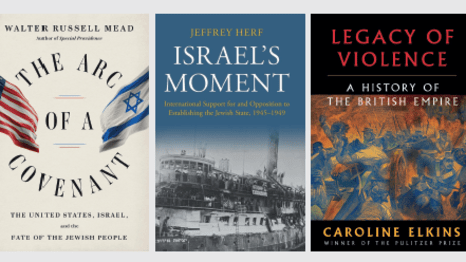Walter Russell Mead, The Arc of a Covenant: The United States, Israel, and the Fate of the Jewish People (Knopf, 2022)
Jeffrey Herf, Israel’s Moment: International Support for Opposition to the Establishing of a Jewish State, 1945–1949 (Cambridge University Press, 2022)
Caroline Elkins, Legacy of Violence: A History of the British Empire (Knopf, 2022)
By Peter Eisenstadt
Just recently, right after the mid-term elections, former president Donald Trump was given the Theodor Herzl medal by the Zionist Organization of America. He told the assembled, to considerable applause that “you do have people in this country that happen to be Jewish that are not doing the right thing for Israel.” Trump is typical of contemporary Christian Zionists, an antisemite who basically hates most American Jews because they vote for the Democrats, but rather than criticize them for being Jewish, he criticizes them for not being Jewish enough. In this, as in so many other ways, Trump is both a breaker of precedent as well as a continuation and intensification of a grand old American gentile tradition, entangling a love for some form of Judaism with a hatred for existing Jews; a semitism that is both “anti” and “philo.”
Walter Russell Mead explores these trends, the inconsistent and often incoherent perception of Jews that run through American history, in his new book. I can’t say I recommend it, because the book, over a thousand pages, is garrulous and rambling, often unconvincing, and poorly sourced. All too often, he makes statements such as “most Americans thought” without providing any evidence on what most Americans did think. The book, largely an account of Protestant America’s encounter with Jews and Zionism, discusses, at wearying length the many species of providentialism, pre- and post-millenarianism, meliorism, catastrophism, supercessionism, and Holy Land-ism, along with other ideological and theological positions into which gentile America has tried to slot the Jews. Mead places in American history into the longest possible of longue durées, with an extended exegesis of the Epistle to the Romans, an account of the expulsion of Jews from England in 1290, with many other examples of foregrounding what should best have been left in the background.
If you are going to add to the Babel (and babble) of books on the history of the relation between the United States and Israel, you need an original hook, and Mead has found an original, albeit dubious, approach. He argues that one problem with most existing histories of the US-Israel relationship is that they are, in his words, too “Jewcentric,” and spend too much with the Jews, and not enough with non-Jews. Mead corrects this bias. (One example: The book has thirteen references to that most nondescript of nineteenth century American presidents, Benjamin Harrison, and three references to Yitzhak Rabin.) So, if you want to read what is likely the most “un-Jewy” history of Zionism and Israel ever written, this is your book. Mead, to make his argument, seriously underplays the popularity of Zionism among Jews prior to World War II, and treats Zionism as largely a fringe movement until then (and seriously overplays the centrality and the longevity of Reform Judaism’s anti-Zionism within the broader history of American Judaism.)
Now, to be fair, the history of the Jews is in good part a history of their interactions with non-Jews, and nothing has happened in last turbulent century of Jewish history to change this. Rather than retreating from the non-Jewish world, the quest for Jewish autonomy has required ever greater involvement with it, as the history of Zionism’s wooing of the great powers and their leaders, from Balfour to Biden, definitely shows. Another example is the efforts of the ferociously anti-Zionist Satmar Hasidim to build a goy-free world for themselves, a largely successful effort that, that has, paradoxically, made them increasingly “American,” as Nomi M. Stolzenberg and David M. Myers argue their marvelous, recent book American Shetl: The Making of Kiryas Joel, a Hasidic Village in Upstate New York.
I read Mead’s book, despite blurbs from the like of George F. Will, Niall Ferguson, Dan Senor, and even Henry Kissinger, that this was an important, even an essential book to read. Caveat lector. And I think the main reason that conservatives like this book is because its central argument is that the notion of an Israel lobby is largely a myth, fabricated by those who believe that Jews control American policy towards Israel, and that people who insist on the existence of the Israel lobby as a force that exerts a gravitational influence on American policy towards Israel are, at best, profoundly mistaken and, at worst, and all too often, antisemites. Instead, argues Mead, American policy has been shaped by long-term American, and largely Christian values towards Israel and Jews.
On the question of the existence of the Israel lobby, Mead is of course wrong. A brief story: Around 2010 I was active in the J Street chapter in Rochester, New York, and one day we had a meeting with the late (and truly great) congresswoman, Louise Slaughter, a progressive stalwart on any number of issues. We asked her to sign a J Street letter calling for negotiations for two states. She declined. She told us, “I’ve been to Israel, I’ve met Netanyahu, and he’s a real son-of-a-bitch. But if I sign your letter, the next day my staff will handle a hundred angry phone calls and emails about it. What protection will you give me? Now, if a downstate Jewish member of Congress, like Chuck Schumer, signed this and gave me a little cover, I would be delighted to sign it.” And that is proof, my friends, that the Israel lobby exists and why Jews play a critical role in it.
Perhaps the core of Mead’s book are the chapters on how non-Jews, notably Harry Truman—whom he insists on calling Cyrus, like the Persian king – and Eleanor Roosevelt, successfully fought off other non-Jews, such as George Marshall and others in the State and Defense Departments to support the creation of Israel, with, again, American Jews relegated to supporting roles. For those interested in this fascinating story, I strongly recommend another recent book, by Jeffrey Herf, Israel’s Moment. The book surprised me, because in recent years I have seen Herf as a combative speaker and writer on Israel/Palestine matters, challenging the accuracy and honesty of Israel/Palestine progressives. But he has always been an excellent historian, and this book is everything that Mead’s is not, crisply argued and meticulously researched.Herf is an archives rat. He exaggerates the importance of Haj Amin al-Husseini, the Mufti of Jerusalem, the arch-villain in so many Zionist histories of 1948, and argues that if he had been tried on war crimes after the war there might have been more Palestinian support for partition, which seems unlikely.
The part of the book I found most instructive are his accounts of the United Nations debates that led to the end of the Mandate. Like Mead, he sees the US State Department as villains, afraid that Israel would become a haven for pro-Soviet leftism—Mapam was being closely watched by both sides in the Cold War in 1948—and Truman and the Soviet bloc as heroes. But unlike Mead, he sees Soviet bloc support for the creation of Israel as more than just Stalin’s machinations and efforts to disrupt British influence in the Middle East, but rather, for many involved (though not Stalin, of course) as a sincere effort to assist Jews and Jewish refugees in what Herf calls the last act of World War II. He quotes at length Alfred Fiderkiewicz, the Polish representative to the UN and vice president of the General Assembly in 1946, who had himself been imprisoned in Auschwitz, on the “close bond” formed between Jews and Poles during the war. He emphasized that Jews had fought the Nazis by themselves as well as with Poles as partisans and in the regular army, and he understood that some Jews “find it psychologically impossible to return to places which to them are cemeteries” along with their “desire to begin a new life in a new land” including Palestine. Likewise, Czechoslovakia’s military support for Israel during the early months of 1948, at a time when the US had an arms embargo, Herf argues, also came out of a genuine sympathy for the plight of the Jews. It is hard not to conclude that many Poles, Czechs, Russians, and other peoples in Eastern Europe simply hated the Nazis and understood the plight of Jews in a deeper and far more visceral way than American diplomats and probably most Americans. As Susan Neiman has pointed out in Learning from the Germans that East Germany and Poland were far more thorough and assiduous in executing Nazi war criminals—the now expiring exception to my opposition to capital punishment—than the pro-US government of West Germany. Would things have been different in Eastern Europe and Israel if Stalin had not, after 1948, started his “anti-cosmopolitan” campaign and thereby gave new life to antisemitism that culminated in the Slansky trial and the Doctor’s Plot, is an interesting and unanswerable question. And contrary to Mead, Herf argues for what never really needed to be argued for, that Jews, worldwide, played the key role in advocating for the creation of Israel. Perhaps Herf wrote his history of the pro-Zionist left to make an invidious comparison with the contemporary pro-Palestinian left. But his book is a reminder that there was, for all people of good will, those who believed in the equality and liberation of all peoples, perhaps no greater unresolved question after the war than the future of the Jews.
But if World War II was a war against Nazism, for many it was also a war against British imperialism. Nowhere else did these war aims collide more forcefully than in wartime and post-war Palestine. A novel approach to this question is provided in Caroline Elkins’s excellent History of Violence, an account of the efforts of the British to hold back the anti-colonial tide in their possessions in the 20th century, and the utter ruthlessness with which they went about this. What is so valuable about Elkins’s book is that it places British violence in Palestine in the context of British violence elsewhere. When Britain established the Mandate in the early 1920s, it soon staffed its police force with veterans of the Black and Tans and other Protestant auxiliaries who were completing their vicious war against Catholics in Ireland and brought their paramilitary tactics, including the copious use of torture, to their work, as well as the lack of distinction between the work of police and that of soldiers. Palestine, particularly after the outbreak of the Arab Revolt in 1936 , became a testing ground for the latest anti-insurgency tactics. Arthur “Bomber” Harris, already an expert in using the RAF against civilians, who would go onto greater fame/infamy during World War II, directed the air war against the Palestinians, strafing the ground with machine guns and dive-bombing Palestinian villages. His work in Palestine led to a promotion. Someone else for whom the war against the Arab Revolt provided a career boost was Major General (and future Field Marshall) Bernard Montgomery, who took charge of actions in Palestine in November 1938. This very modern major general felt that, in Palestine at least, to “win a war of this sort, you must be ruthless,” which he was. In 1939, preparing for bigger battles, he returned to Britain, with fond memories. “I shall be sorry to leave Palestine in many ways,” he said, as I have enjoyed the war out here.” O, what a lovely war. And then, in 1939, with a shift of geopolitical winds, Britain decided it needed to encourage Arab support, issued the White Paper that limited Jewish emigration, and Britian’s war against the Arabs became, especially after 1945, a war against the Zionists. Elkins in her book charts the mutual atrocities in that war, and its aftermath, that the hardened British forces that departed Palestine soon found themselves employed in other anti-insurgency conflicts, notably in Malayaand Kenya, employing the lessons learned in the fight against the Jews. One way to look at the history of Palestine from 1936 to 1948 is as a country that fought two separate wars against British imperialism, with both sides learning respective lessons in ruthlessness. This is not to exonerate either side, but to place the struggles of both the Jews and the Palestinians in the broader context of their anti-imperialist struggles.
Elkins has it in for liberals—why is liberalism invariably judged by its most hypocritical representatives?—and favors radicals, those who took up arms against the British. So her account of the end of British India concentrates on Subhas Chandra Bose, who met with Hitler during the war, the leader of the anti-British India National Army, rather than Mahatma Gandhi. And in her account of the endgame in Mandatory Palestine, she has much more to say about Menachem Begin and the Irgun than Ben-Gurion and the Haganah. There is justice in this. Begin was perhaps the most successful fighter against British imperialism of them all, and I liked her treating Begin like Bose, the Chinese Malayan leader Chin Peng, Jomo Kenyetta of Kenya, and others. (What Begin shared with his future Rose Garden handshake-mate, Anwar al-Sadat, was a burning hatred of British imperialism, and the struggle against it profoundly shaped both men.) But what Britain bequeathed to both sides was the legacy of thirty years of a brutal military occupation, the conviction that the other side can only “understand” violence and terror. To the new state of Israel the British example fostered the illusion that you can indefinitely maintain democracy at home and rule by naked military force (in the near) abroad.
Reading these books together left me more depressed than not, and raised a question. Most countries, certainly Israel and the United States, were born and came of age amid violence and atrocity. The question is whether any county, so conceived, can ever really move beyond its origins or are they condemned, in some form or another, to endlessly recapitulate their birth traumas in some sort of Sisyphean circularity of the damned?
For many recent observers, the answer is yes. We have often read in recent years that no country can rise above their birth in barbarism. Violence and racism are inherent, their original sin, bred in the bone, inherited in both the American and Israeli national “DNA.” First, let me say that we need to examine the national history of both countries with a cold eye, without exculpation, without prettifying. But at the same time, I intensely dislike both of these metaphors. St. Augustine wrote of original sin not to damn everyone to hell for all of eternity, but to encourage sinners to join the Body of Christ, and thereby have their original sin expunged. As for DNA, what can I say; there is no national DNA. We humans are not amoebas, we reproduce sexually, which means that every child inherits their genetic material from two genetically distinct parents; thus every child has a unique mixture. So generation by generation, a country’s “DNA” is always changing. And it isn’t clear what, for any nation, their “dominant” and “recessive” traits are and whether they are fixed. We inherit much, and we change what we inherit and then pass it all on to the next generation, which repeats the process.
Elkins’s book with its attacks (often much deserved) on British liberals had me pondering the old question—what is the difference between a “liberal” and a “radical”? Let me add to the existing blizzard of definitions. A liberal thinks that they can change and transform their country within its existing institutions, learning lessons from the horrors of its past. Radicals, on the other hand, think that their country can only deal with its rotted institutions by demolishing them, razing them to the ground, and starting completely anew. Do the rises and falls and rises of Donald Trump and Benjamin Netanyahu mean that both countries will perpetually re-enact the worst aspects of their past in new guises? Or is a genuinely new history possible? I do not know. No one knows. But when it comes to the future of both countries, half of me is a liberal, and half of me is a radical.
___

Peter Eisenstadt is a member of the board of Partners for Progressive Israel and the author of Against the Hounds of Hell: A Biography of Howard Thurman (University of Virginia, 2021).







Leave A Comment